Reef Art as Environmental Activism
Coral reefs around the world are vanishing at alarming rates due to climate change, pollution, and other human-driven factors. Despite growing scientific evidence, global policy to protect reef ecosystems is essentially not there. In the face of this crisis, artists around the world have used creative expression to raise awareness and inspire action. Art can often reach people in ways that raw data and statistics cannot, offering new perspectives on the urgency of environmental issues. Here we give details on three unique artistic responses to coral reef degradation: the Crochet Coral Reef, the EDP Art Reef, and The ReefLine. From handcrafted yarn structures to underwater installations made from decommissioned coal plant parts, each project merges aesthetics with advocacy, demonstrating how art can play a powerful role in ecological preservation.
EDP Art Reef
- Creator: Alexandre Farto aka Vhils
- Date: 2021-2023
- Location: Albufeira, Portugal
- Medium: Sculpture/Installation art
What is the EDP Group?
EDP Group (formally Energias de Portugal) is a portuguese electric company focused on the global transition to clean renewable energy with the goal of becoming 100% green by 2030. The company has a global reach, as they serve energy clients across four key regions: Europe, North America, South America, and the Asia Pacific. As of 2024, EDP’s produced energy consists of 86% renewables, 5% coal, 9% combined cycle gas turbine (CCGT), and 1% from other energy sources.
What is the EDP Art Reef?
The EDP Art Reef is an underwater art exhibition composed of 13 large sculptures each created from repurposed parts of deactivated coal-fired power plants and live corals that were germinated in captivity. This project was launched through a partnership between Portuguese artist Alexandre Farto (also known as Vhils) and EDP, with the support of numerous collaborators including the Albufeira City Council, Turismo de Portugal, Albufeira Marina, Plant a Coral, and others.
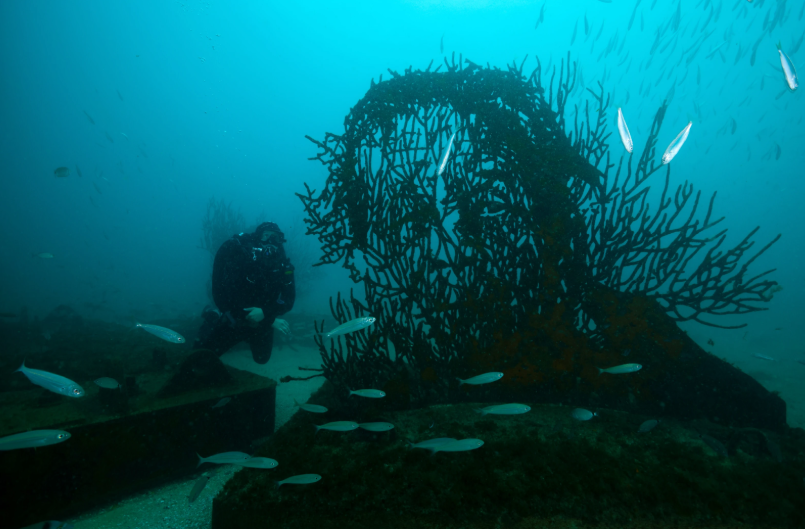
 Farto, Alexandre (Vhils). “Underwater sculpture from EDP Art Reef.” EDP Art Reef, Vhils Studio,(https://vhils.com/en/projects/edp-art-reef). Accessed 29 May 2025
Farto, Alexandre (Vhils). “Underwater sculpture from EDP Art Reef.” EDP Art Reef, Vhils Studio,(https://vhils.com/en/projects/edp-art-reef). Accessed 29 May 2025
Vhils designed this installation to merge art with environmental restoration, with the ultimate goal for these structures to be fully colonized by coral, eventually evolving into vibrant, self-sustaining marine ecosystems. The sculptures are designed to be visited and admired by divers and are submerged at a depth of 10 to 15 meters in the Atlantic Ocean, just off the coast of Albufeira, Portugal. The location was selected based on three main criteria: proper distance from shore, proper depth, and having a placement between a rock formation and the shore to ensure durability.
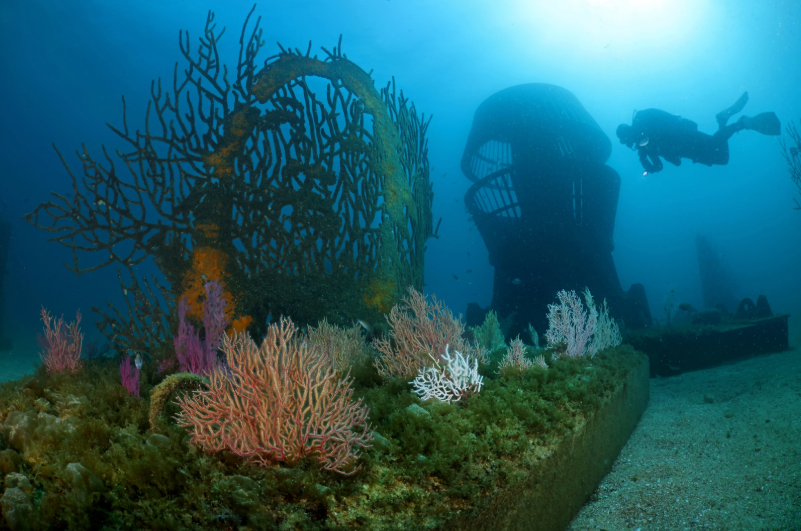
 Farto, Alexandre (Vhils). “Underwater sculpture from EDP Art Reef. EDP Art Reef, Vhils Studio,(https://vhils.com/en/projects/edp-art-reef) Accessed 29 May 2025.
Farto, Alexandre (Vhils). “Underwater sculpture from EDP Art Reef. EDP Art Reef, Vhils Studio,(https://vhils.com/en/projects/edp-art-reef) Accessed 29 May 2025.
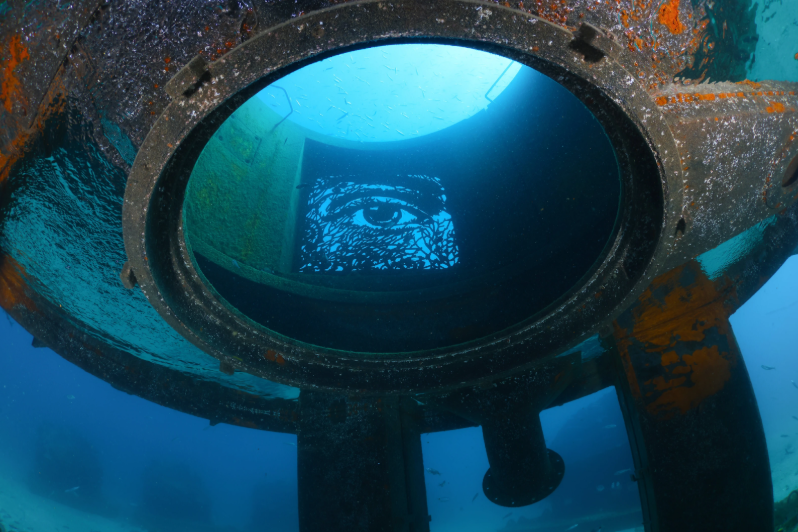

Farto, Alexandre (Vhils). “Underwater sculpture from EDP Art Reef.” EDP Art Reef, Vhils Studio, (https://vhils.com/en/projects/edp-art-reef) Accessed 29 May 2025
What is the Arts Meaning and Impact?
The EDP Art Reef carries a powerful message about the interconnectedness of humanity and the ocean. Featuring faces, footprints, and scenes blending urban and natural elements, the artwork is designed to provoke reflection on the relationship between people and the sea. It emphasizes the vital link between ocean health and human well-being, bringing awareness to the importance of coral reef and marine conservation. Additionally, the installation has gained significant attention, adding to its mission of drawing awareness, including being featured in Time magazine as one of 2024’s “Worlds Greatest Places.”
Beyond generating awareness about the world’s degrading coral reefs, the installation serves a practical purpose by supporting coral reef restoration. The sculptures provide a substrate for coral colonization, and early signs of coral growth have already been observed. Furthermore, the project also symbolizes the global shift toward clean energy. By reporting parts from decommissioned coal-fired power plants, the EDP Art Reef offers a sustainable method of dismantling old energy infrastructure while also contributing to environmental restoration. This transition not only supports the health of marine life but also promotes broader efforts to combat climate change.
Additionally, the installation provides an ecotourism opportunity for Portugal, as it is a beautiful underwater attraction that will draw divers to Albufeira. It stands as a compelling example of how art, sustainability, and innovation can intersect to raise awareness and drive meaningful environmental change.
The ReefLine
- Creator: Ximena Caminos (Artistic Director)
- Date: 2025-2026
- Location: Miami Beach, Florida
- Medium: Sculpture/Installation art
What is The ReefLine?
The ReefLine is a proposed underwater sculpture, hybrid reef, and environmental advocacy project set to materialize throughout 2025 and 2026. Artistic director Ximena Caminos, a Miami resident, founded The ReefLine non-profit organization and the artistic project along with several partners, with the main goals of encouraging local change and revitalizing the third-largest barrier reef system in the world – the Florida Reef Tract.
This project will be a 7+ mile underwater sculpture park, located within swimming distance of Miami Beach’s shores, designed as a snorkel trail filled with environmentally friendly art pieces that double as artificial reefs and provide habitat for a wide diversity of marine species. The ReefLine and its partners also hope that this snorkeling experience will create connections and raise awareness in the local community and in visitors to the importance of reef habitats and inhabitants, and even divert tourists and divers from more vulnerable natural reef systems.
The Phases
The ReefLine will be composed of 4 major artistic installations, set to be implemented in phases throughout a two year period. Phase 1, taking place in late 2025, includes the submersion of a concrete recreation of Leandro Erlich’s Order of Importance (2019), twenty-two ‘cars’, symbolically reversing the harm done to the natural environment by actual motor vehicles.
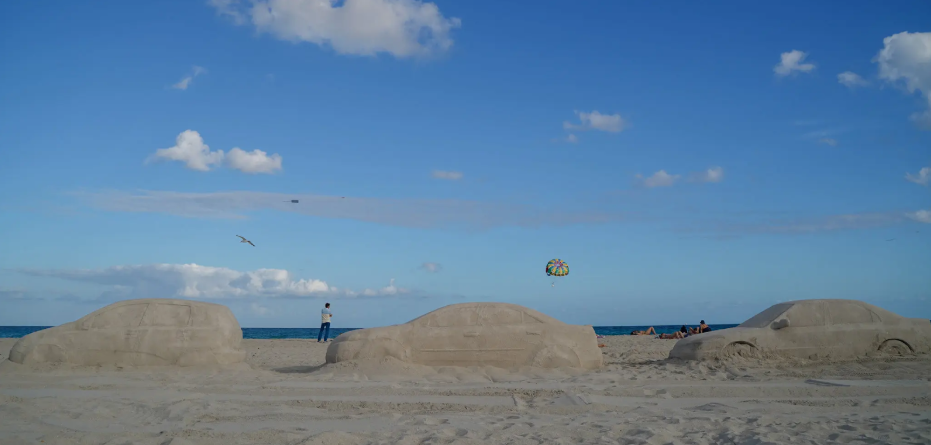
 Leandro Erlich’s Order of Importance, 66 life-sized sand sculptures exhibited at Miami Art Week in 2019. Valentin, Angel. The New York Times, Dec 3 2019,(https://www.nytimes.com/2019/12/03/arts/leandro-erlich-artist-Miami-Beach)
Leandro Erlich’s Order of Importance, 66 life-sized sand sculptures exhibited at Miami Art Week in 2019. Valentin, Angel. The New York Times, Dec 3 2019,(https://www.nytimes.com/2019/12/03/arts/leandro-erlich-artist-Miami-Beach)
Phase 2, taking place in 2025-2026, includes the implementation of 3 art installations: Carlos Betancourt and Alberto Latorre’s Miami Reef Stars, Petroc Sesti’s Heart of Okeanos, and Shohei Sigematsu’s modular super structure. As with the concrete cars of Phase 1, all of these installations hope to serve the role of artificial reefs and artistic attractions for snorkelers.
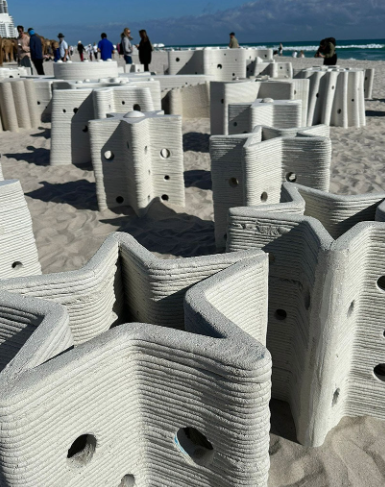
 Scaled-down 3D printed concrete prototype of the Miami Reef Stars on display at Miami Beach in December of 2024. Barandy, Kat. designboom, Dec 6 2024,(https://www.designboom.com/art/3d-printed-concrete-miami-reef-star-prototype-reefline-beach-12-06-2024/)
Scaled-down 3D printed concrete prototype of the Miami Reef Stars on display at Miami Beach in December of 2024. Barandy, Kat. designboom, Dec 6 2024,(https://www.designboom.com/art/3d-printed-concrete-miami-reef-star-prototype-reefline-beach-12-06-2024/)
The project gets its name (The ReefLine) from a line of limestone boulders connecting these installations, acting as the snorkel path, substrate for corals, habitat for fish and creatures, and a regulating force for large waves in an effort to protect the hybrid reef and the coastline.
The Future of the Project
While this project is still in the works as of June 2025, and has been pushed back a few times already, The ReefLine has made several positive moves in the direction of its installation, including securing a $5 million grant from Miami Beach’s Arts and Culture General Obligation Bond in November of 2022, and through smaller-scale demonstrations meant to expose the public to the project. Additionally, The ReefLine will get a chance to further promote their project at the United Nations Ocean Conference 2025 this June in Nice, France, where they will be exhibiting 41 carbon-sequestering Miami Reef Star modules. It is still difficult to determine the effectiveness of The ReefLine as an artificial reef in terms of providing habitat for marine life, diverting tourists, and raising awareness. Some argue that similar projects, such as Cancún’s Underwater Museum of Art, while achieving the goal of attracting marine life and diverting tourists, also divert attention from the fact that the largest threats to coral reefs exist on a much larger scale than tourist based damage– such as coastal development, increased intensity of storms due to anthropogenic climate change, and anthropogenic global warming. As with all efforts to conserve, protect, and revitalize coral reef ecosystems, artistic projects alone cannot solve the issue of the degradation of these precious habitats, but hopefully they can raise broader awareness and incite localized changes.
Crochet Coral Reef
- Creators: Christine & Margaret Wertheim
- Date: 2008-2025
- Exhibit: Has been shown internationally
- Medium: Yarn, plastic, string, and more
What is the Crochet Coral Reef?
The Crochet Coral Reef is an artwork exhibit responding to climate change and acts as a global exercise in raising awareness about the effects on coral reef ecosystems. It was created by Christine and Margaret Wertheim; twin sisters who grew up in Australia. They created the first Crochet Coral Reef together in their living room in 2005. As the project gained momentum, the Wertheims called out to volunteers from all over the world to aid them in their artwork. The project became a huge collaboration between mostly women who created the larger exhibit that became the Crochet Coral Reef.
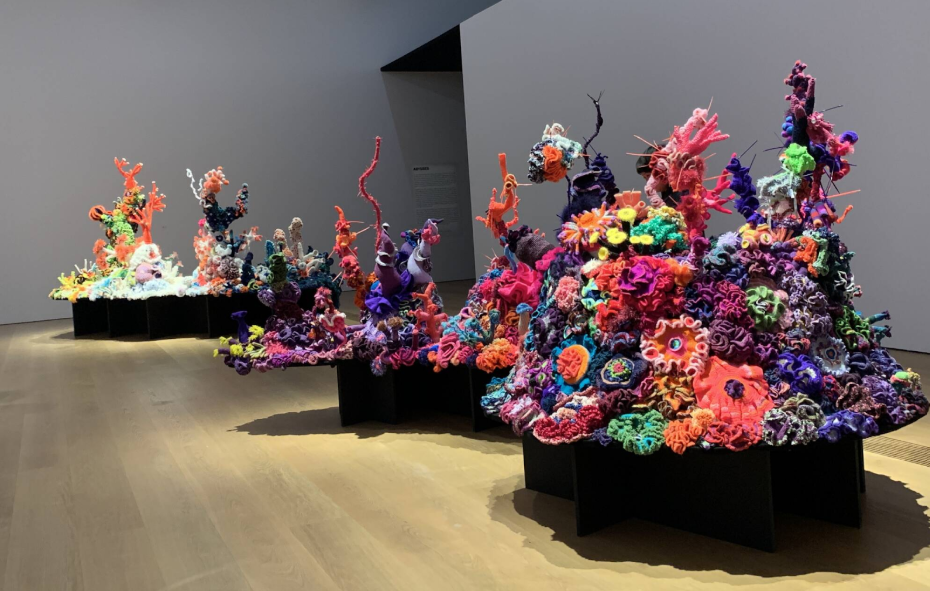
 Baden Baden Satellite Reef at Musee Cantonal des Beaux Arts (Lausanne, Switzerland, 2024). Photo © Institute For Figuring
Baden Baden Satellite Reef at Musee Cantonal des Beaux Arts (Lausanne, Switzerland, 2024). Photo © Institute For Figuring
Deeper Connections to Coral
The crochet reef is a thoroughly thought out combination of art and science. The artwork explores the real life creation and workings of coral and emphasizes coral reef’s importance in the scientific world. Crochet can be described as a code, with different stitches having distinct symbols to represent them. This connects to how living organisms create themselves using the most common coding system on Earth: DNA. Math is also used to determine the shape of the created coral.
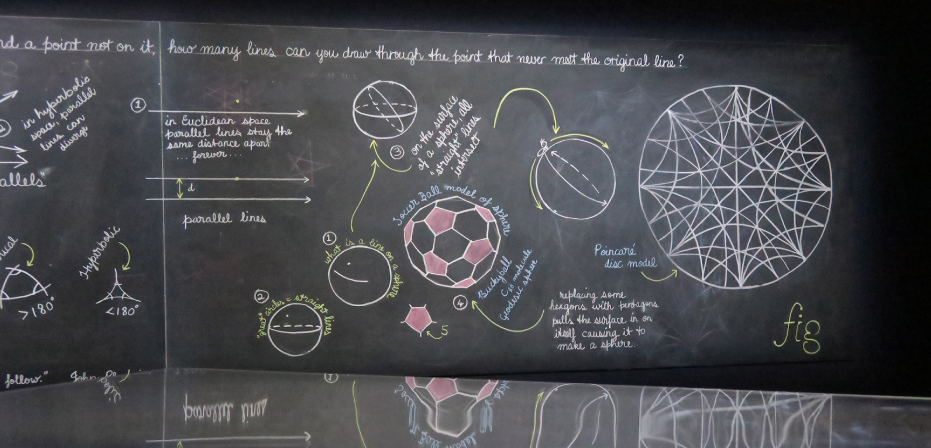
 Mathematics Blackboard, at the 2019 Venice Biennale. Photo © Institute For Figuring
Mathematics Blackboard, at the 2019 Venice Biennale. Photo © Institute For Figuring
The time it takes for the artists to create such extraordinary displays closely represents the time it takes for coral reefs to grow and flourish. Time plays an important role in coral reefs, especially now. Every year, the amount of CO2 emitted into the atmosphere by anthropogenic means increases. This leads to ocean temperatures rising. The increase in temperatures is dangerous for coral’s health. The zooplankton that live inside the coral polyps cannot withstand the rising temperatures. And without the zooplankton, the coral struggles to produce its own energy. The Crochet Coral Reef is raising awareness about coral bleaching by not only creating colorful depictions of coral, but constructing bleached and dead coral as well.
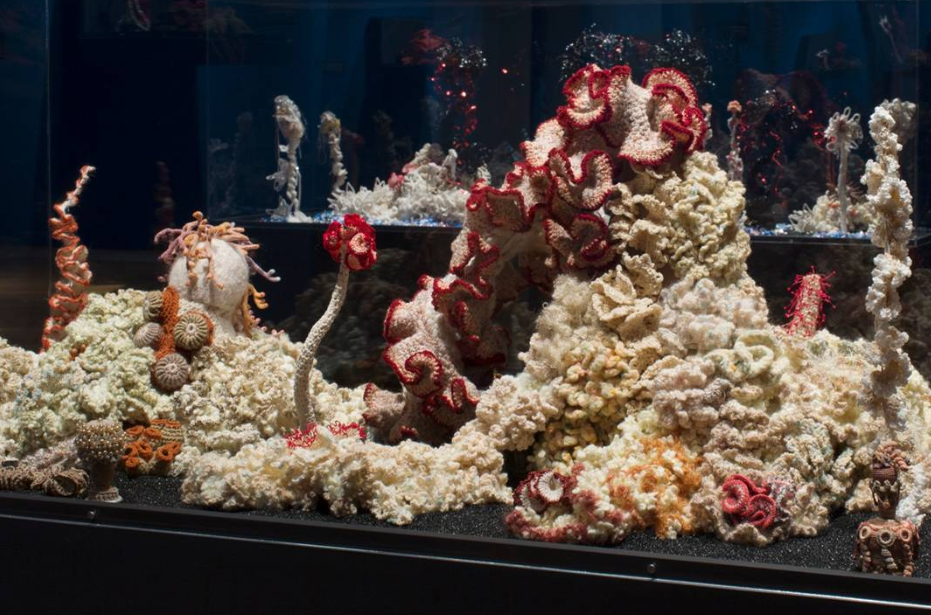
 Bleached Reef, at the Museum of Arts and Design (NYC)). Photo by Jenna Bascom for MAD.
Bleached Reef, at the Museum of Arts and Design (NYC)). Photo by Jenna Bascom for MAD.
In addition to depicting bleached and broken coral, the Crochet Coral Reef has a plastic version of coral. While the colorful yarn reefs represent organic living creatures, the plastic reefs emphasize the growing amount of plastic collecting in our oceans. These reefs are made entirely out of recycled materials; shopping bags, bottles, zip ties, bubble wrap, and other common plastic products. The plastic depiction of coral appeals to the public’s emotions and makes it easier for people to realize the effects of pollution of coral reefs.
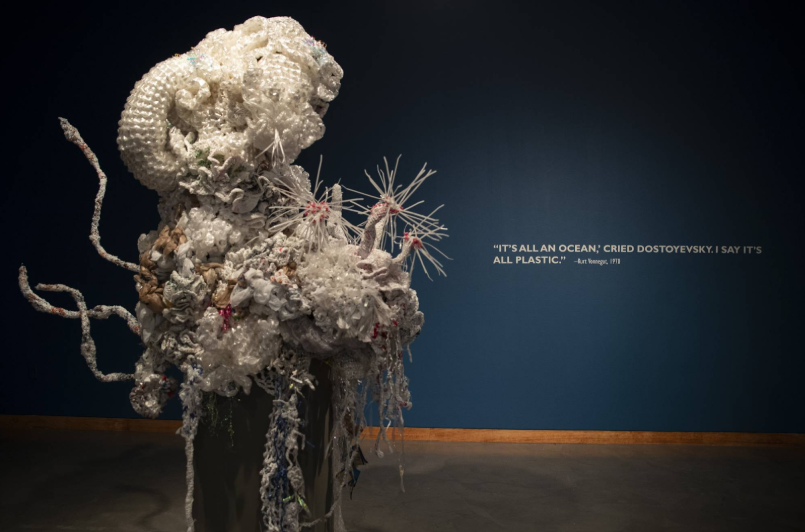
 Coral Forest – Nin Imma, crocheted from plastic shopping bags and Saran wrap, at Lehigh University Art Galleries. Photo by Stephanie Veto for LUAG.
Coral Forest – Nin Imma, crocheted from plastic shopping bags and Saran wrap, at Lehigh University Art Galleries. Photo by Stephanie Veto for LUAG.
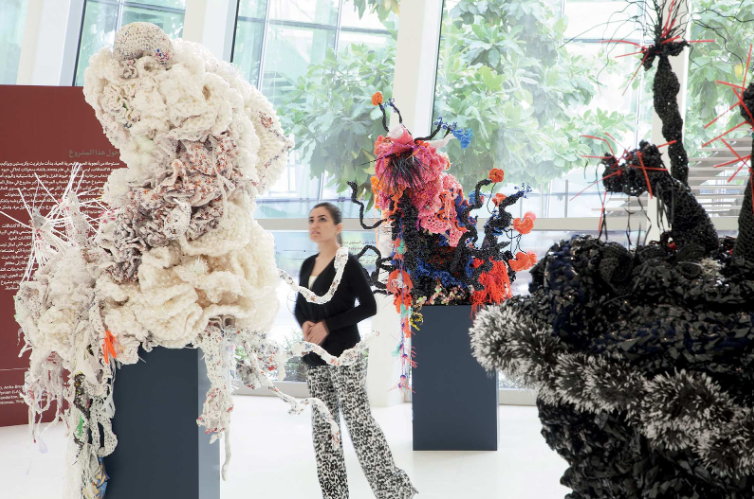
 Coral Forest at the NYU Abu Dhabi Institute. White form (Coral Forest – Nin Imma), crocheted from shopping bags and Saran wrap; black form (Coral Forest – Chthulu), made from video tape, tinsel and cable ties; pink form (Coral Forest – Ea), made from shopping bags and discarded plastic debris. Photo by Christina Simons for the Institute For Figuring.
Coral Forest at the NYU Abu Dhabi Institute. White form (Coral Forest – Nin Imma), crocheted from shopping bags and Saran wrap; black form (Coral Forest – Chthulu), made from video tape, tinsel and cable ties; pink form (Coral Forest – Ea), made from shopping bags and discarded plastic debris. Photo by Christina Simons for the Institute For Figuring.
Awareness
The Crochet Coral Reef’s purpose is to raise awareness on the destruction of coral reefs due to human beings. The toxic and plastic reefs appeal to the emotions of the audience. Most of the time, a visual representation of destruction can appeal to more emotion than an article or data set. The crocheted reef can be described as a “message of hope;” a representation of what humans can accomplish when working together while not waiting for someone else to develop a technological solution out of nowhere.
While no single artwork can reverse the damage done to coral reef ecosystems, projects like the Crochet Coral Reef, EDP Art Reef, and The ReefLine show the potential of art to inspire change. These installations do more than just show the ocean’s beauty, they challenge viewers to confront the consequences of human actions and imagine different futures. Through community collaboration, ecological restoration, and public engagement, each exhibit highlights the power of art to educate, provoke empathy, and motivate sustainable action. As we continue to face environmental degradation, these creative efforts remind us that solutions can come not only from science and policy, but also from the human imagination. By blending creativity with environmental awareness, these projects turn art into a powerful form of activism. They show that beauty and purpose can work together to create meaningful conversations and inspire real change.
Sources
Blois, Matt. “Mexico’s Underwater Museum Is Diverting Attention to Environmental Issues.” Earth Island Journal, (https://www.earthisland.org/journal/index.php/articles/entry/mexicos_underwater_museum_diverting_attention_environmental_issues)
Caraway-Carlton, Angela. “The ReefLine.” Greater Miami & Miami Beach, (https://www.miamiandbeaches.com/travel-interests/green-miami/the-reefline)
Crochet Coral Reef. About the Project, (https://crochetcoralreef.org/about/theproject/)
Crochet Coral Reef. Art + Science Overview, (https://crochetcoralreef.org/artscience/plastictrash/)
Crochet Coral Reef. Plastic Trash, (https://crochetcoralreef.org/artscience/plastictrash/)
“Crochet Coral Reef: Toxic Seas: By Margaret and Christine Wertheim and the Institute for Figuring.” Museum of Arts and Design, (https://madmuseum.org/exhibition/crochet-coral-reef-toxic-seas)
“EDP Art Reef: Decarbonise to Create Art and Life.” EDP, EDP Group, (https://www.edp.com/en/media/edp-stories/edp-art-reef-decarbonise-create-art-and-life)
Farto, Alexandre. “Alexandre Farto Aka Vhils - EDP Art Reef.” Vhils, (https://vhils.com/en/projects/edp-art-reef)
McGibbon, Melissa. “Unconventional and Otherworldly Underwater Art Exhibit Unveiled in Algarve, Portugal.” Scuba Diving, 11 Oct. 2023, (https://www.scubadiving.com/underwater-art-reef-exhibit-unveiled-algarve-portugal)
Roberts, Siobhan. “The Crochet Coral Reef Keeps Spawning, Hyperbolically.” The New York Times, 2024, (https://www.nytimes.com/2024/01/15/science/mathematics-crochet-coral.html)
Sykes, Krista. “The ReefLine: An Unprecedented Underwater Sculpture Park Brings Art, Marine Habitats, and Public Education to Miami Beach.” Harvard Graduate School of Design, 13 May 2025, (https://www.gsd.harvard.edu/2025/05/the-reefline-an-unprecedented-underwater-sculpture-park-brings-art-marine-habitats-and-public-education-to-miami-beach)
The ReefLine. BlueLab Preservation Society, (https://thereefline.org)
“The ReefLine Preview.” Instagram, uploaded by The ReefLine, (https://www.instagram.com/reel/DJHSHFNuglu/)
Ward, Terry. “EDP Art Reef: World’s Greatest Places 2024.” Time, Time, 25 July 2024, (https://time.com/6992352/edp-art-reef/)
“What We Do.” EDP, (https://www.edp.com/en/what-we-do)